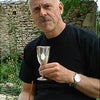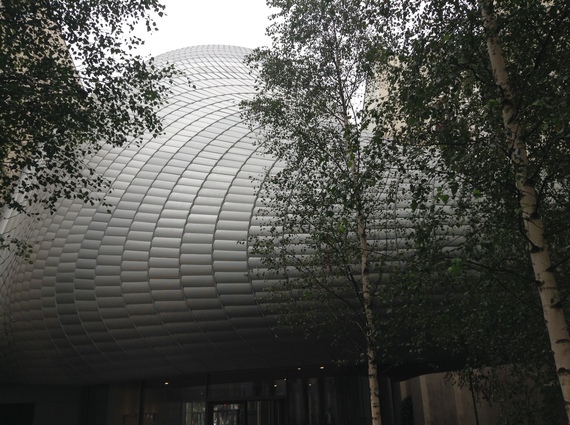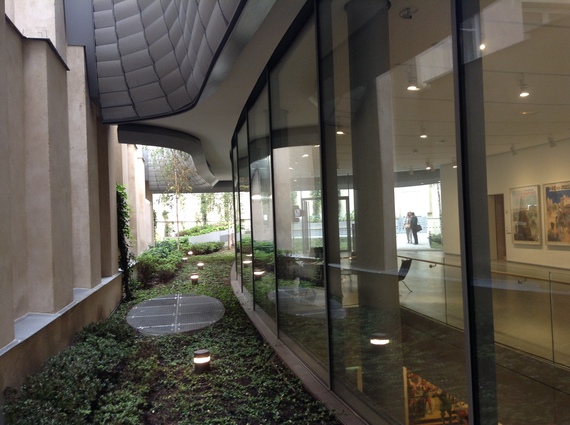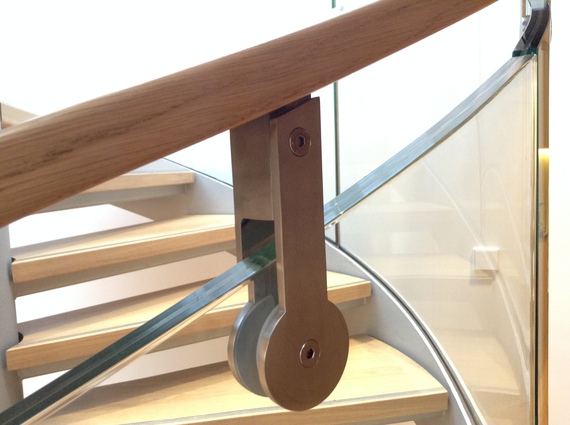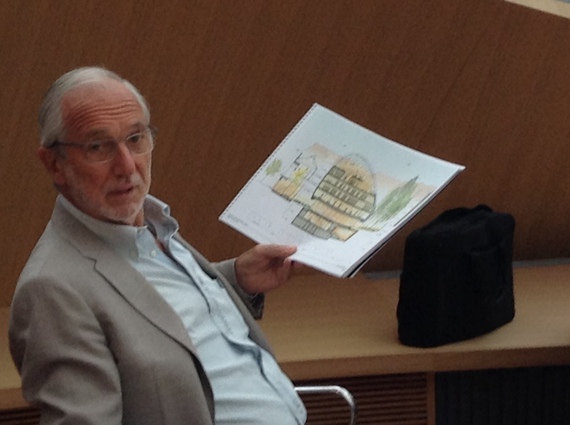Renzo Piano, notwithstanding his Pritzker Prize, seems a gentle man as his name might suggest. He speaks in a soft voice and listens carefully to the questions posed to him. It was especially so at the inauguration of his latest building in Paris, the city where he made his name with the world famous Pompidou Museum of Modern Art almost 40 years ago.
The new building is squeezed tightly between two seven-story apartment buildings in a space once occupied by a small 19th century theatre. It houses the Fondation Pathé-Jerome Seydoux and holds what may be the largest archive of 20th century films, posters, cameras and documents anywhere in the world. Pathé at one point, well before MGM, was the world's largest movie production company. The Foundation is open to anyone who asks to use it, but it's the building itself that is most startling.
It looks like a giant worm with a short tale, or as Piano joked, a leaping whale with a shiny metal comb skin. The reason very simply is that Piano, who's known as a master problem solver, had to figure out how to install five stories of tables, desks, archives, meeting spaces and an auditorium into what had been a few hundred square feet of ground surface -- bearing in mind all the constraints guaranteeing air and light to the cheek by jowl neighbors on either side.
Outside in the back is a large garden court planted with crepe myrtle complemented by slender trees crawling up the rear neighbor's wall. The front of the building retains the old theatre's stone façade protected as a national monument because it was hand carved by a then young unknown sculptor named Auguste Rodin.
History is inescapable in the buildings of Paris, and building is in Piano's blood. Before Piano and his team were finished they had constructed 60 physical models before deciding on the final design.
"I'm a builder," Piano told me in a brief interview. "I grew up in a family of builders. A real one. The one that did the job. They didn't just manage other builders -- they built the building. I became an architect I suppose because I wanted to run away from home, to go somewhere else to study something else. But in my scheme," he laughed, "I start with the pleasure to build."
A contrast is often made between Piano and his competitive friend and colleague Frank Gehry whose greatest fame came from the Guggenheim Museum in Bilbao and the very similar Disney Concert Hall in LA. Gehry was long known as a "paper architect" -- or a an architect whose startling forms mostly existed on paper but were never built. If all architects are basically problem solvers, Gehry was said to start with form and find a technical solution while Piano begins with technique and discovers the form.
"This is the joke Frank and I keep doing. We normally start from a technical issue. He normally starts with a shape, but it's not really true" Piano said. He consistently spoke of "we" -- his team -- not "I", the genius.
You know you start from somewhere. It doesn't matter where you start. What matters is where you end. You don't work for six months on technique and then go on to form. We start in this case, [the Fondation Pathé] with a small space and we have to find some way to do it. Almost immediately we started to think about how we do that, because we have to create a safe place, and then maybe we have to go up to breathe fresh air and see the roofs of Paris. You combine the idea that you need to be in a little space and you combine that with technique.
At the top it can maybe be translucent or transparent? Or why not wood? So you combine. At the same time you also combine poetry. Light. Transparency. Breathing. All of that. In some way, you never start by one view -- technique -- and then you move to something else. It's always pushing everything together.
There are architects and especially developers who look first at the program -- what the client demands -- and then at the budget. A good building in Piano's view should start with a client who has a very focused idea, and it should only take a few pages. The program for Fondation Pathé was hardly more than one page: a worldwide movie archive open to the public.
From the first minute -- or maybe the second or third (he smiles) we're thinking about making a small building in the middle of Paris. So socially speaking, existentially speaking, to have a little space where people can meet, where they can stay together. So this... [must have] those different inspirations... social, cultural, poetry, construction. They mix, and they are not really divided.
Let's say as an architect at 9 o'clock in the morning, you are poet. At 10 o'clock, you become the builder. At 11 you become, I don't know, the business guy, because we have to think about money, cost of construction. Then at mid-day you become a little poet. That's a kind of a switching constantly. Then people look at me like someone who just loves technique, but it's really not true.
